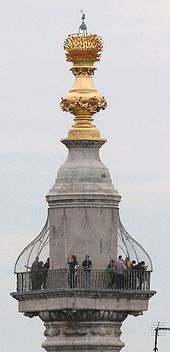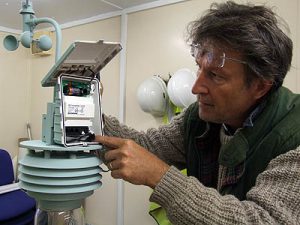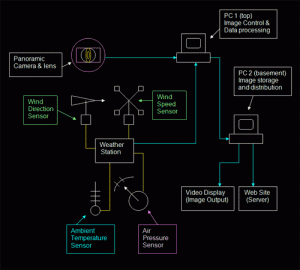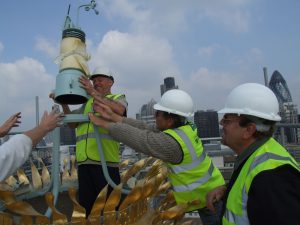The Monument Project (Si Monumentum Requiris Circumspice) (2009-2011)

Creator:
Meigh-Andrews, Chris-
Year: 2009
Type of work:Installation
Funding source: City of London Corporation and Julian Harrap Architects
Technical details: Site Specific installation, The Monument to the Great Fire of London. Digital camera, custom camera housing, computers, custom image processing software, Kidan 360 lens.
In 2007 I was commissioned to produce an ambient responsive outdoor installation on the Monument by Julian Harrap Architects. This work was produced in collaboration with Sandbox at the University of Central Lancashire with funding from the City of London Corporation. The installation, which was operational between Feb 2007 and Aug 2011, provided a live stream of continually modified time-lapse images 24 hours a day, 7 days per week and could be accessed via a dedicated web site. The web site also made available a continuously updated series of still images of the panorama from the top of the Monument, as well as providing background information about the project. The panoramic images were digitally unfolded from the circular images that were produced by the camera/lens system at the heart of the installation. Link to a short video documenting the installation of the camera housing on top of the Monument in 2009

Installing the weather station on the camera housing, 2009 A computer controlled digital camera provided a 360-degree panoramic view from the top of the Monument. Changes to the image display were facilitated by a dedicated computer system with interfaces and software that modified the image in response to changes in the ambient conditions of the surrounding environment, specifically wind velocity and direction, average temperature and barometric pressure. This data was used to modify the live image stream from the camera in a number of different ways relating to the changes in the weather, so for example the speed of the image stream related to the wind speed, and the rotation of the image related to the wind direction. Ambient temperature modified the colour of the image, whilst changes in the pressure modified the image contrast. The resulting images which were designed to be presented on a dedicated outdoor screen adjacent to the Monument, provided a dynamic visual record of the surrounding environment of the Monument in the heart of the City of London. Although the project is now completed and the live image is longer being produced, some examples of images and time-lapse sequences produced by the installation can be seen on the City of London’s Monument web site.

Diagram of the image system for “The Monument Project” Some Background to the Installation Project
This work was both a development from my previous digital video projects, particularly Interwoven Motion, (2004) and For William Henry Fox Talbot (The Pencil of Nature), (2002) and a departure, in that it was a public art work commissioned and designed to operate continuously for three years. As with many of my previous installations, Si Monumentum…. was site-specific and in part responded to aspects of the history of the site- the Monument, designed by Sir Christopher Wren and Robert Hooke as a monument to the Great Fire of London in 1666 and to the subsequent resurrection and re-emergence of the City of London. Many of my previous installations including For William Henry Fox Talbot and Interwoven Motion have also been directly related to the site they occupy and to the particular artists and scientists associated with them. I am especially interested in constructing works that resonate with the building or location of the original- the oriel window at Lacock Abbey which was the subject of the world’s oldest surviving photograph, or the view of Coniston Water in the English lakes in Cumbria favoured by Ruskin, for example.
The Monument was of particular interest to me because it was designed by Wren and Hooke as both an architectural structure and a scientific instrument. Both men lived during a period in English history in which radical new ideas about science, religion and politics were sweeping away previously held convictions, and at a time when the activities of the artist and the scientist were more integrated and interrelated. Both men established their reputations initially as scientists before consolidating their careers as architects. Wren was made Gresham Professor of Astronomy in 1657 (age 24!) and Hooke became Gresham Professor of Geometry in 1665, and was curator of experiments a the Royal Society. Both were gifted draughtsmen, using their skills to vividly sketch their observations and ideas. Hooke and Wren were fascinated by optics, mathematics and the scientific method, and when they developed their plans for the Monument, they ensured that it would be useful to the continuation of their experimental work. For example the massive hollow column of the Monument originally contained a telescope, the spiral staircase steps were designed to facilitate the measure of barometric pressure and the Monument’s height, at 202 ft, was ideal for experiments with the forces of gravity.
Their Monument to the Great Fire is sited close to the spot where that infamous blaze began in 1666, and from the observation platform near the top, the visitor can survey the city that rose from the ashes. As architects, Hooke and Wren were instrumental in the rebuilding of the city. Given Wren and Hooke’s interest in optics and lenses, and their crucial contribution to the development of London after the fire, the challenge to develop a camera system capable of providing a complete panoramic image of the surrounding cityscape was a wonderful and unique opportunity. I wanted to develop a way of presenting an image of continuous flux, an image that responded to the changing weather conditions, the fluctuating light, and the dynamic vista at the heart of the City of London.
Chris Meigh-Andrews, January, 2009.

Installing the Camera -


